Rear of 29 Bathurst St, Hobart (closer to Melville St). Google Maps
Opened 1824.
Replaced in 1835 by the larger St Andrews/Scots Church.
Now St Andrews Hall, behind the newer church.
Rear of 29 Bathurst St, Hobart (closer to Melville St). Google Maps
Opened 1824.
Replaced in 1835 by the larger St Andrews/Scots Church.
Now St Andrews Hall, behind the newer church.
Tamar St, Launceston. Google Maps.
Opened 1837. Adjoining hall opened 1896. Church demolished 1920.
From “The Days Of Our Youth, Early Launceston: the early churches”:
The Congregationalists were represented in the first instance by the Rev. Charles Price, who arrived at Launceston in September, 1832, and on the 23rd of that month preached for the first time in the Court House, which was then in Cameron-street, near where the post office now stands. After staying four months, Mr. Price went to Sydney, re turning in 1836. He obtained a grant of 3/4-acre of land in Tamar-street, and in September of the following year the Tamar-street Church was erected at a cost of about £1300. In 1842 a second Congregationalist Church (the present “Milton Hall”) was opened by the Rev. John West (Tasmania’s historian), who arrived in the colony in 1838, having been sent by the Colonial Missionary Society. Services in the meantime were held in the infant school-room in Frederick-street. Mr. Price, in addition to labouring gratuitously for 14 years, built in 1848, at his own expense, the little Wycliffe chapel in Vincent-street, off St. John-street, for the greater convenience of some aged members of his congregation. In 1858 he also induced his Tamar-street adherents to erect a chapel at Inveresk.
Examiner, 17 March 1906
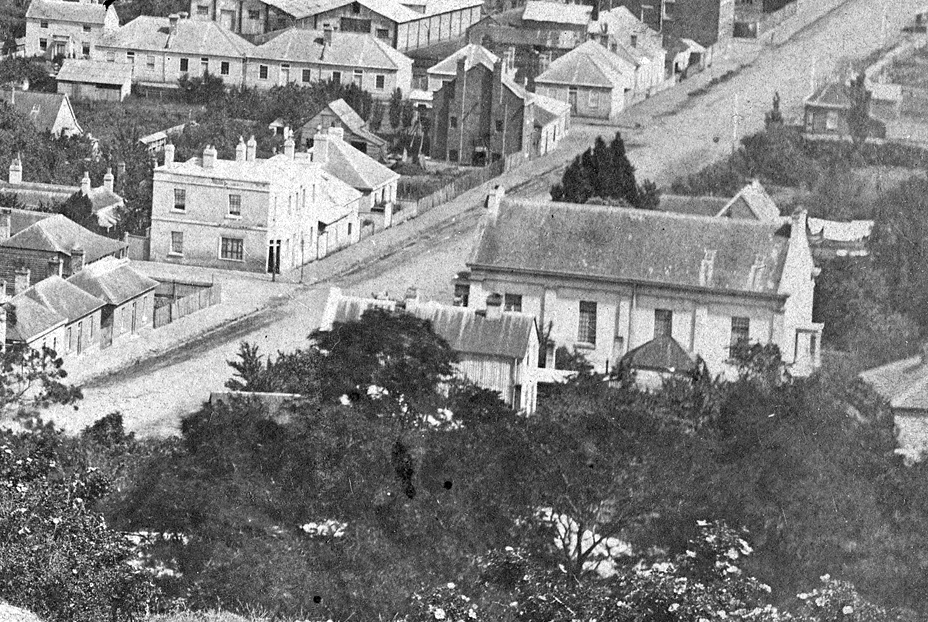
View from Windmill Hill, 1860s, showing Tamar Street. Chapel is the larger building on the right of the street
(cropped from photo in QVMAG Collection, QMV:1983:P:1196)
163 Macquarie St,Hobart. Google Maps.
Opened 1841, as the first permanent Catholic church in Hobart, and acted as the cathedral before St Mary’s was completed.
Background to development of Catholic churches in Hobart.
Drawing, 1843
Lithograph, 1844
Two postcards
Interior, stereograph, c.1865
As far back as 1817 Father Flynn called at the settlement, on his voyage from England to Sydney, and administered the sacrament, and four years later Father Connolly arrived and commenced his work. He celebrated mass at Mr. Curr’s store in Argyle-street, and there the congregation consisted of nine persons. Services were subsequently held in the old building in Elizabeth-street, known to us in later years as “Rats’ Castle.” Father Connolly having obtained a grant of 14 acres of land at the angle of Harrington and Brisbane streets, called it Mount Carmel, and in February, 1822, a small wooden church was commenced. It was finished in the following year, and dedicated to God, under the invocation of St. Virgilius.
The Mercury, 31 December 1904
ROMAN CATHOLIC CHAPEL
THE Resident Roman Catholic Clergyman in Van Diemen’s Land, in Furtherance of the Object with which he is intrusted, under the Authority of His Majesty’s Government, being desirous to put in Progress the Building of a suitable Place of Worship for the Roman Catholics, with the Sanction of His Honor the Lieutenant Governor, respectfully calls upon such of the Inhabitants as are disposed to give their Aid to this desirable Object, as connected with the good Order of a large Portion of the Persons already in Van Diemen’s Land, and of others probably yet to arrive ; and he respectfully requests to add, that a Subscription List is open at the under-mentioned Places :
At the Office of Edward Lord, Esq. ; of Messrs. Kemp and Co. ; of Edward Curr, Esq. ; at the House of P. A. Mulgrave, Esq. and at the Gazette Office, Hobart Town.
At the House of T. A, Lascelles, Esq. New Norfolk ; James Gordon, Esq. Pitt Water; and G. W. Gunning, Esq. Coal River.
At Port Dalrymple:-Thomas Archer, Esq. J. P.; Mr. Commissary Roberts ; T, C, Simpson, Esq. ; and James Cox, Esq. J. P.
Where the Contributions of all Persons will be thankfully received.
It is considered scarcely necessary to state, that the Catholic Community, for whose particular Accommodation and Good this Undertaking is about to be commenced, will be expected to give their Aid in every Shape in which it can be useful, and suitable to their Condition.
Hobart Town Gazette, 13 April 1822
I’m not sure on actual location on the chapel, but it appears to have been close to the corner of Harrington & Brisbane Sts. In 1831, an advertiser gives his location as “situated in Brisbane-street, at the corner of Harrington street, (opposite the Roman Chatholic Chapel). In 1833, a cottage is advertised for sale at the “premises in Brisbane street facing the Catholic Chapel”. In 1834, another advertiser gives his location as “opposite the Catholic Chapel, Harrington Street”.
Foundation stone laid 1817
Consecrated 1823 (although in use before then)
Steeple replaced 1835
Became St David’s Cathedral 1842
Demolished 1874 after completion of new (current) building
Plan : Plan : Front elevation : Rear elevation, : Side elevation : Cross-section : Plan for “altering and enlarging” : Front elevation with new tower
GOVERNMENT AND GENERAL ORDERS.
GOVERNMENT HOUSE, HOBART TOWN,
Tuesday, February 18, 1817.
THE Civil and Military Officers are requested to attend at Government House To-morrow Morning at Half-past Eleven o’clock A.M. to accompany the Reverend ROBERT KNOPWOOD to the Ground prepared to lay the Foundation Stone of St. David’s Church. In Consequence of which, the same will be observed as a Holiday throughout the Settlement; and the Acting Assistant Commissary General will cause to be issued to each of the Non-commissioned Officers and Private Soldiers, Superintendents, Overseers, Constables, and other Persons in the actual Employ of Government, Half-a-Pint of Spirits.
By Command of His Honor,
The Lieutenant Governor,
J.B. BOOTHMAN, Clerk.
Hobart Town Gazette, 22 February 1817
Continue reading
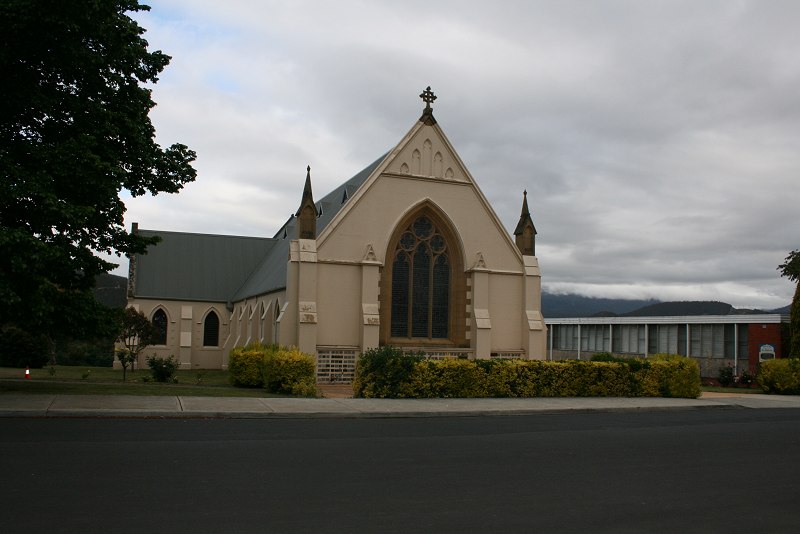
St Matthews lays claim to being the oldest Anglican Church in Tasmania, bring opened in 1823. An article in the Mercury written for the St Matthew’s centenary in 1925 talks about the history of the church:
Mr. Knopwood retired in 1823 from the chaplaincy of Hobart, and come to live in
New Norfolk, and in the same year the inhabitants of New Norfolk applied to
the Governor-in-Chief at Sydney that he might be appointed chaplain of New Nor-
folk, stating that there was a brick school which could be used as a temporary
church.
The arrival of the official minister, Rev Hugh Robinson two years later, and his first service, is the date used for the centenary:
The beautiful church of St. Matthew’s as it now is, its gabled roof, stained glass windows, and noble chancel, is a very different building from what it was when the church was first erected. All that is left of the original building are the walls and flagged floor of the nave, and possibly the western walls of what are now the transepts. And even as to these there is a certain amount of doubt. The foundation stone of the chancel has on it the words, “Erected in 1825, Chancel added in 1894.” But there was a schoolhouse which, begun in 1823, was finished in 1824. Whether this was the present nave or part of it is uncertain, though there is little doubt that a portion of the present church was originally built for a school. It was not used definitely as a church till Mr. Robinson’s time, for, it was in the month that he arrived there, August, 1825, that tenders were submitted for church furniture, and a pulpit, reading desk and communion table put in the building. The carpentry work in the building was of a poor quality; for on Sunday, December 4, 1825, a portion of the ceiling fell in.
As well as obtaining the fittings, that year there was construction work taking place:
We understand with much pleasure, that New Norfolk, the favourite retirement of
Colonel Sorell and other distinguished characters, is rapidly becoming improved.
The church, in which the Rev Robert Knopwood, M. A. regularly preaches has been
considerably enlarged.
Hobart Town Gazette, 22 April 1825
At New Norfolk, the Church is roofed in, and completed.
Hobart Town Gazette, 20 August 1825
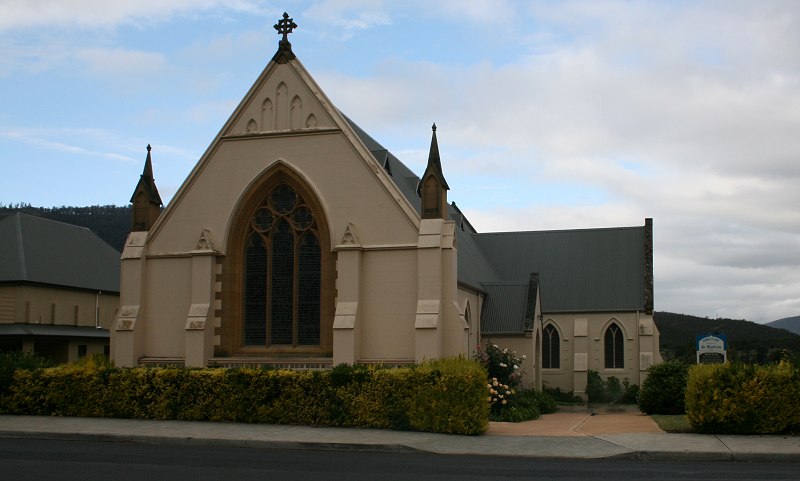
Since that time, the building has been extensively modified and its appearance has dramatically changed. A postcard from the State Library of Victoria with an illustration c.1825 and an engraving from LINC Tasmania, published in 1834 both show a church building very different to that in the above photo.
More recent photos:
This one is dated 1890s (prior to the rebuilding in 1894?)
This, from the early 20th century, has a more familiar form.
Continue reading
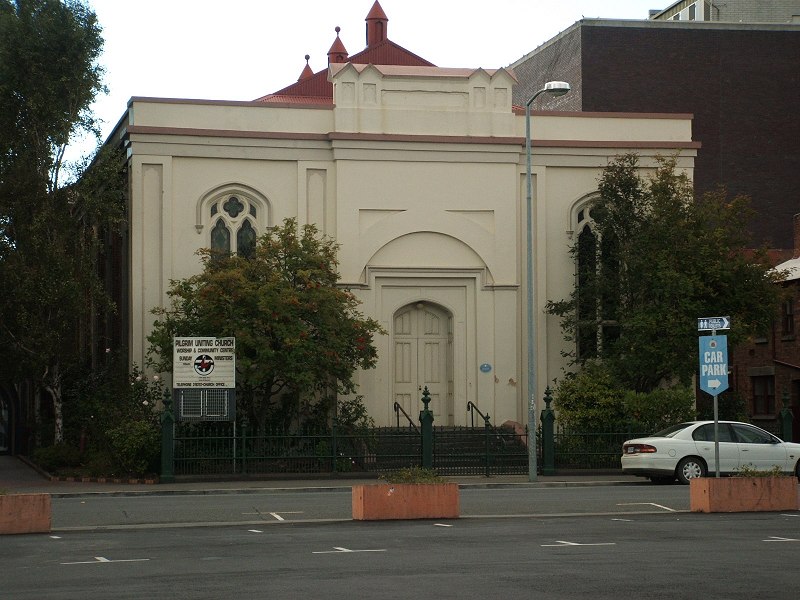
Built and opened in 1835.
Location on Google Maps
An earlier chapel was built further along the street, just past George St, where the Anglican Holy Trinity Church is now. In the 1860s, the congregation out grew the chapel and a larger church was built next door, which is now the Pilgrim Uniting Church. This former chapel is now the church hall.
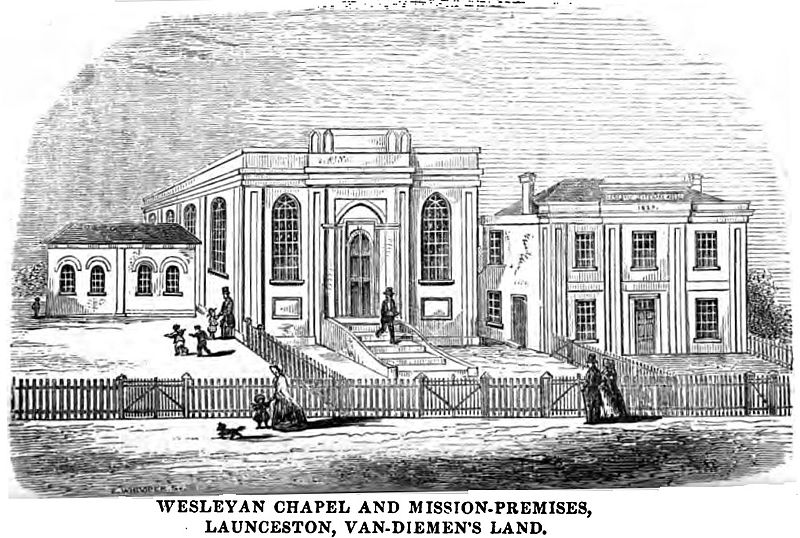
From Wikipedia Commons.
Lower Charles St, Launceston. Google Maps.
Opened 1833, as a single storey brick building. When the congregation moved to a newer, larger kirk in Paterson St, the building was sold and has seen various uses including as stores, a printery and offices. It was during this later period that it gained the second storey and new front part.